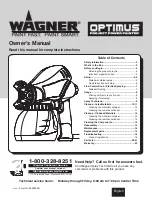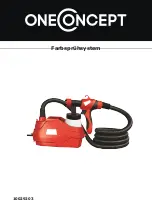
4
INTRODUCTION
HVLP stands for High Volume, Low Pressure. This is a type of spraying that allows you to spray extremely
accurately but without all the overspray that occurs with the high pressure tank type equipment. In fact, in some
parts of the world the high pressure systems are banned by law on environmental grounds and HVLP type
systems are the only alternative for professional type spraying. This gun is extremely easy to use, very safe
and reduces the amount of paint used.
IMPORTANT SELECTING PAINT
This is a highly versatile spray kit that can be used with several different spray mediums including varnishes,
wood preservatives, enamels, oil and water based paints and automotive paints. However some materials
cannot be sprayed so please check the recommendation of the manufacturer before
buying the paint. If a
material
refers to brush application only then it usually cannot be sprayed.
THIS UNIT CANNOT BE USED FOR TEXTURED PAINTS. USE OF THESE MATERIALS WILL CAUSE
PREMATURE WEAR, WHICH WILL VOID THE GUARANTEE.
TO OBTAIN THE BEST RESULTS FROM YOUR SPRAY KIT PLEASE READ THE INSTRUCTIONS
CAREFULLY BEFORE USE.
PREPARATION
Preparation of the surface and thinning of the paint are the two most important areas to be concerned with to
obtain the best results from your spray kit.
Ensure all surfaces are free from dust, dirt, rust and grease. If necessary rub down with sandpaper, or similar.
Masking of areas is important to ensure you do not spray those areas you wish to remain untouched.
THINNING
Your spray kit is supplied with a viscosity cup. Viscosity is a technical term used to indicate if a product is very
thin or very thick. If thin, the viscosity is said to be low, while if very thick the viscosity is said to be high.
Viscosity is measured in seconds. In order to spray some materials they need to be “thinned” (diluted).
Thinning is very important when spraying. Most paints are supplied ready for brush application and
may need
to be thinned (diluted)
for spraying purposes
.
Follow the manufacturers guide for thinning in conjunction with a spray gun. If in doubt please contact the
manufacturers of the paint. The viscosity cup supplied will help you determine the correct thickness of the paint.
Paint is “thinned” by adding the substance which the paint is based upon. If a water based paint then water is
added, if oil based then white spirit.
As some paints, wood preservatives and other sprayable materials contain particles that have grainy material,
please ensure that when filling the paint container of the spray gun, that the paint is filtered through either a
funnel with a filter on it or through nylon tights or stockings. This will ensure that no large particles enter the
paint container, so preventing blockages and providing you with trouble free spraying. Ensure that a face mask,
gloves and goggles are worn at all times when spraying.
Water based paints and
25 - 50 seconds
emulsions
Oil based paints
45 - 50 seconds
Wood preservatives
No dilution
Primers
45 - 50 seconds
Varnishes
No dilution
Aluminium paints
No dilution
Wood stains
No dilution
Automotive Paint
Manufacturers ratio
IDEAL VISCOSITY
This spray gun can be used with products having a viscosity ranging from 25 to a maximum
of 50
seconds.
Dip the viscosity cup into the material and fill up. Time how long it takes for
the viscosity cup to empty (Fig 1).
Using the above chart (or manufacturer’s instructions) as a guide determine if the material
requires further thinning, if so then thin accordingly.
If the paint requires thinning, start with a 10% dilution of the paint. To do this, fill a 1litre
container with the required paint. The viscosity cup supplied with the unit holds 1/10 of a
litre, block the hole in the viscosity cup and fill up with the required thinner. Add the thinner
to the paint and stir, measure the viscosity using the recommended viscosity chart above.
If the paint requires further thinning, dilute the paint by another 5% (5% will be equal to half a viscosity cup)
with the required thinner and measure the viscosity, if the paint is not at it's recommended viscosity, repeat the
above step.
Note: Some paints are outside the ranges listed above. Please contact our helpline for further information.
Fig.1
L0482 01-07.qxd 25/7/08 10:36 am Page 4


























